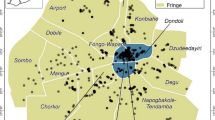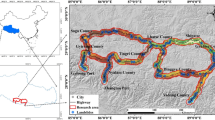Abstract
A critical step for kriging in geostatistics is estimation of the variogram. Traditional variogram modeling comprise of the experimental variogram calculation, appropriate variogram model selection and model parameter determination. Selecting of the variogram model and fitting of model parameters is the most controversial aspect of geostatistics. Shapes of valid variogram models are finite, and sometimes, the optimal shape of the model can not be fitted, leading to reduced estimation accuracy. In this paper, a new method is presented to automatically construct a model shape and fit model parameters to experimental variograms using Support Vector Regression (SVR) and Multi-Gene Genetic Programming (MGGP). The proposed method does not require the selection of a variogram model and can directly provide the model shape and parameters of the optimal variogram. The validity of the proposed method is demonstrated in a number of cases.
















Similar content being viewed by others
References
Al-Ahmari A (2007) Predictive machinability models for a selected hard material in turning operations. J Mater Process Technol 190:305–311. doi:10.1016/j.jmatprotec.2007.02.031
Atteia O, Dubois JP, Webster R (1994) Geostatistical analysis of contamination in the Swiss Jura. Environ Pollut 86:315–327
Basak S, Dixit U, Davim J (2007) Application of radial basis function neural networks in optimization of hard turning of AISI D2 cold-worked tool steel with a ceramic tool. Proc Inst Mech Eng B J Eng Manuf 221:987–998
Byvatov E, Schneider G (2003) Support vector machine applications in bioinformatics. Appl Bioinforma 2:67–77
Çaydas U, Ekici S (2012) Support vector machines models for surface roughness prediction in CNC turning of AISI 304 austenitic stainless steel. J Intell Manuf 23:639–650. doi:10.1007/s10845-010-0415-2
Çaydaş U, Hasçalık A (2008) A study on surface roughness in abrasive waterjet machining process using artificial neural networks and regression analysis method. J Master Process Technol 202(1):574–582. doi:10.1016/j.jmatprotec.2007.10.024
Cevik A, Guzelbey IH (2007) A soft computing based approach for the prediction of ultimate strength of metal plates in compression. Eng Struct 29:383–394. doi:10.1016/j.engstruct.2006.05.005
Cevik A, Sonebi M (2008) Modelling the performance of self-compacting SIFCON of cement slurries using genetic programming technique. Comput Concr 5:475–491
Chen YK, Yang YG, Wu WW (2015) Coal seam thickness prediction based on least squares support vector machines and kriging method. Electron J Geotech Eng 20(1):167–176
Chilès JP, Delfiner P (2012) Geostatistics: Modeling spatial uncertainty, 2nd edn. Wiley, New York
Clark I (1979) Practical geostatistics. Applied Science Publishers, Essex
Clark I (1983) Regression revisited. Math Geol 15(4):517–536
Clark I, Harper WV (2000) Practical geostatistics 2000. Greyden Press, Ecosse North America
Cressie N (1985) Fitting variogram models by weighted least squares. Math Geol 17(5):563–586
Cressie N (1991) Statistics for spatial data. Wiley, New York
Desassis N, Renard D (2013) Automatic variogram modeling by iterative least squares: univariate and multivariate cases. Math Geosci 45:453–470. doi:10.1007/s11004-012-9434-1
Deutsch CV, Journel AG (1998) GSLIB: geostatistical software library and user’s guide, 2nd edn. Oxford University Press, New York
Emery X (2010) Iterative algorithms for fitting a linear model of coregionalization. Comput Geosci 36:1150–1160. doi:10.1016/j.cageo.2009.10.007
Fernández-Casal R, Francisco-Fernández M (2014) Nonparametric bias-corrected variogram estimation under non-constant trend. Stoch Environ Res Risk Assess 28:1247–1259. doi:10.1007/s00477-013-0817-8
Gandomi AH, Alavi AH (2011) Multi-stage genetic programming: a new strategy to nonlinear system modeling. Inf Sci 181:5227–5239. doi:10.1016/j.ins.2011.07.026
Gandomi AH, Alavi AM (2012) A new multi-gene genetic programming approach to non-linear system modeling. Part II: geotechnical and earthquake engineering problems. Neural Comput Applic 21:189–201. doi:10.1007/s00521-011-0735-y
Gandomi AH, Alavi AH, Mousavi M, Tabatabaei SM (2011) A hybrid computational approach to derive new ground-motion prediction equations. Eng Appl Artif Intell 24:717–732. doi:10.1016/j.engappai.2011.01.005
Garg A, Tai K (2012) Review of genetic programming in modeling of machining processes. In: Proceedings of the 2012 I.E. International Conference on Modelling, Identification and Control (ICMIC2012). Wuhan, China, 24–26 June 2012, pp. 653–658
Garg A, Tai K (2013) Comparison of statistical and machine learning methods in modeling of data with multicollinearity. Int J Model Identif Control 18(4):295–312
Garg A, Tai K (2014) Stepwise approach for the evolution of generalized genetic programming model in prediction of surface finish of the turning process. Adv Eng Softw 78:16–27. doi:10.1016/j.advengsoft.2014.08.005
Garg A, Bhalerao Y, Tai K (2013a) Review of empirical modeling techniques for modeling of turning process. Int J Model Idenfit Control 20(2):121–129. doi:10.1504/IJMIC.2013.056184
Garg A, Rachmawati L, Tai K (2013b) Classification-driven model selection approach of genetic programming in modeling of turning process. Int J Adv Manuf Technol 69:1137–1151. doi:10.1007/s00170-013-5103-x
Garg A, Garg A, Tai K, Sreedeep S (2014a) An integrated SRM-multi-gene genetic programming approach for prediction of factor of safety of 3-D soil nailed slopes. Eng Appl Artif Intell 30:30–40. doi:10.1016/j.engappai.2013.12.011
Garg A, Garg A, Tai K (2014b) A multi-gene genetic programming model for estimating stress-dependent soil water retention curves. Comput Geosci 18:45–56. doi:10.1007/s10596-013-9381-z
Garg A, Tai K, Gupta AK (2014c) A modified multi-gene genetic programming approach for modeling true stress of dynamic strain aging regime of austenitic stainless steel 304. Meccanica 49:1193–1209. doi:10.1007/s11012-013-9873-x
Garg A, Tai K, Lee CH, Savalani MM (2014d) A hybrid M5′-genetic programming approach for ensuring greater trustworthiness of prediction ability in modeling of FDM process. J Intell Manuf 25(6):1349–1366. doi:10.1007/s10845-013-0734-1
Genton MG (1998) Variogram fitting by generalized least squares using an explicit formula for the covariance structure. Math Geol 30(4):323–345
Goovaerts P (1997) Geostatistics for natural resources evaluation. Oxford University Press, New York
Goovaerts P, Webster R, Dubois JP (1997) Assessing the risk of soil contamination in the Swiss Jura using indicator geostatistics. Environ Ecol Stat 4:31–48
Gupta AK (2008) Predictive modeling of turning operations using response surface methodology, artificial neural networks and support vector regression. Int J Prod Res 48:763–778. doi:10.1080/00207540802452132
Hadi Y, Ahmed SG (2006) Assessment of surface roughness model for turning process. Knowledge enterprise: intelligent strategies in product design. Manuf Manag 207:152–158
Hearst MA, Dumais S, Osman E, Platt J, Scholkopf B (1998) Support vector machines. Intell Syst Appl IEEE 13:18–28
Hilário M, Manuela SM (2011) Combining robustness with efficiency in the estimation of variogram. Math Geosci 43:363–377. doi:10.1007/s11004-010-9308-3
Huang ZS, Wang HZ, Zhang R (2012) An improved kriging interpolation technique based on SVM and its recovery experiment in oceanic missing data. Am J Comput Math 2:56–60. doi:10.4236/ajcm.2012.21007
Jian X, Olea RA, Yu YS (1996) Semivariogram modeling by weighted least squares. Comput Geosci 22:387–397
Journel AG, Huijbregts CJ (1978) Mining geostatistics. Academic, London
Kecman V (2001) Learning and soft computing: support vector machines, neural networks, and fuzzy logicmodels. MIT Press, Cambridge
Kerry R, Oliver MA (2007) Sampling requirements for variograms of soil properties computed by the method of moments and residual maximum likelihood. Geoderma 140(4):383–396. doi:10.1016/j.geoderma.2007.04.019
Kitanidis PK (1983) Statistical estimation of polynomial generalized covariance functions and hydrologic applications. Water Resour Res 19(4):909–921
Kitanidis PK (1997) Introduction to geostatistics: applications to hydrology. Cambridge University Press, New York
Koza JR (1994) Genetic Programming. II: Automatic Discovery of Reusable Programs. MIT, Cambridge
Lahiri S, Lee Y, Cressie N (2002) On asymptotic distribution and asymptotic efficiency of least squares estimators of spatial variogram parameters. J Stat Plan Inference 103(1):65–85. doi:10.1016/S0378-3758(01)00198-7
Lark RM (2000) Estimating variogram of soil properties by the method-of-moments and maximum likelihood. Eur J Soil Sci 51:717–728
Lark RM (2012) Towards soil geostatistics. Spat Stat 1:92–99. doi:10.1016/j.spasta.2012.02.001
Lark RM, Webster R (2006) Geostatistical mapping of geomorphic surfaces in the presence of trend. Earth Surf Process Landf 31(7):862–874. doi:10.1002/esp.1296
Lark RM, Cullis BR, Welham SJ (2006) On optimal prediction of soil properties in the presence of trend: the empirical best linear unbiased predictor (E-BLUP) with REML. Eur J Soil Sci 57(6):787–799. doi:10.1111/j.1365-2389.2005.00768.x
Li SH, Lu WT (2010) Automatic fit of the variogram. Third International Conference on Information and Computing (ICIC) 4:129–132. doi:10.1109/ICIC.2010.303
Madár J, Abonyi J, Szeifert F (2005) Genetic programming for the identification of nonlinear input–output models. Ind Eng Chem Res 44:3178–3186
Marchant BP, Lark RM (2007a) The Matérn variogram model: implications for uncertainty propagation and sampling in geostatistical surveys. Geoderma 140(4):337–345. doi:10.1016/j.geoderma.2007.04.016
Marchant BP, Lark RM (2007b) Robust estimation of the variogram by residual maximum likelihood. Geoderma 140(1):62–72. doi:10.1016/j.geoderma.2007.03.005
Mardia KV, Marshall RJ (1984) Maximum likelihood estimation of models for residual covariance in spatial regression. Biometrika 71(1):135–146
Matheron G (1962) Traite de geostatistique appliqué, vol I. Memoires du bureau de recherches geologiques et minieres, no 14. Editions Technip, Paris
Matheron G (1963) Principles of geostatistics. Econ Geol 58:1246–1266
McBratney AB, Webster R (1986) Choosing functions for semivariograms of soil properties and fitting them to sampling estimates. J Soil Sci 37:617–639
Minasny B, McBratney AB (2005) The Matern function as a general model for soil variograms. Geoderma 128:192–207
Oliver MA (2010) Ch. B6: the variogram and kriging. In: Fischer MM, Getis A (eds) Handbook of applied spatial analysis: software tools, methods and applications. Springer, Berlin, pp 319–352. doi:10.1007/978-3-642-0364-7_17
Oliver MA, Webster R (2014) A tutorial guide to geostatistics: computing and modeling variograms and kriging. Catena 113:56–59. doi:10.1016/j.catena.2013.09.006
Pannatier Y (1996) Variowin: software for spatial analysis in 2D. Springer, New York
Pardo-Igúzquiza E, Dowd PA (2001) Variance-covariance matrix of the experimental variogram: assessing variogram uncertainty. Math Geol 33:397–419
Pelckmans K, Suykens JAK, Vangestel T, De Brabanter D, Lukas J, Hamers B et al (2002) LS-SVMlab: a matlab/c toolbox for least squares support vector machines. Tutorial. KULeuven-ESAT, Leuven
Pyrcz MJ, Deutsch CV (2006) Semivariogram models based on geometric offsets. Math Geol 38(4):475–488. doi:10.1007/s11004-005-9025
Ricardo AO (2006) A six-step practical approach to semivariogram modeling. Stoch Environ Res Risk Assess 20:307–318. doi:10.1007/s00477-005-0026-1
Salgado DR, Alonso FJ (2007) An approach based on current and sound signals for in-process tool wear monitoring. Int J Mach Tools Manuf 47(14):2140–2152. doi:10.1016/j.ijmachtools.2007.04.013
Salgado DR, Alonso FJ, Cambero I, Marcelo A (2009) In-process surface roughness prediction system using cutting vibrations in turning. Int J Adv Manuf Technol 43:40–51. doi:10.1007/s00170-008-1698-8
Saptoro A, Tade MO, Vuthaluru H (2012) A modified Kennard-Stone algorithm for optimal division of data for developing artificial neural network models. Chem Prod Process Model 7(1):13. doi:10.1515/1934-2659.1645
Searson DP, Leahy DE, Willis MJ (2010) GPTIPS: an open source genetic programming toolbox for multigene symbolic regression. Proceedings of the International MultiConference of Engineers and Computer Scientists (IMECS 2010), Hong Kong, 1, pp. 77–80
Shi D, Gindy NN (2007) Tool wear predictive model based on least squares support vector machines. Mech Syst Signal Process 21(4):1799–1814. doi:10.1016/j.ymssp.2006.07.016
Stein ML (1988) Asymptotic distributions of minimum norm quadratic estimators of the covariance function. Ann Stat 16:55–63
Suykens JAK, Vannderwalle J, Moor BD (2001) Optimal control by Least squares support vector machine. Neural Netw 14(1):23–35. doi:10.1016/S0893-6080(00)00077-0
Vapnik V (1995) The nature of statistical learning. Springer, New York
Wackernagel H (2003) Multivariate geostatistics, 3rd edn. Springer, Berlin
Wang B, Yao M, Zhu R (2011) Gene expression programming with multiple chromosomes. Int J Model Identif Control 14:235–241. doi:10.1504/IJMIC.2011.043144
Webster R, Oliver MA (2007) Geostatistics for environmental scientists, 2nd edn. Wiley, Chichester
Webster R, Atteia O, Dubois JP (1994) Coregionalization of trace metals in the soil in the Swiss Jura. Eur J Soil Sci 45:205–218
Zhang H, Zimmerman DL (2007) Hybrid estimation of semivariogram parameters. Math Geol 39(2):247–260. doi:10.1007/s11004-006-9070-8
Zimmerman DL (1989) Computationally efficient restricted maximum likelihood estimation of generalized covariance functions. Math Geol 21(7):655–672
Acknowledgments
This study was jointly supported by the Research of High-grade Iron Ore Formation Mechanism and Prediction of China (2012CB416800) and the Fundamental Research Funds for the Graduate Innovation State Education Ministry (N110601002). We are very grateful to Dr Isobel Clark and Dr Pierrre Goovaerts who made geostatistical data available on the internet. We are thankful to three of anonymous reviewers for their constructive comments. We are also very grateful to Earth Science Informatics editor, Dr. Hassan A. Babaie. Their careful review and editorial comments were very useful for the preparation of a revised version.
Author information
Authors and Affiliations
Corresponding author
Additional information
Communicated by: H. A. Babaie
Rights and permissions
About this article
Cite this article
Han, C., Wang, J., Zheng, M. et al. New variogram modeling method using MGGP and SVR. Earth Sci Inform 9, 197–213 (2016). https://doi.org/10.1007/s12145-016-0251-9
Received:
Accepted:
Published:
Issue Date:
DOI: https://doi.org/10.1007/s12145-016-0251-9




